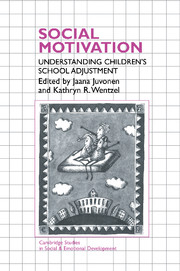Book contents
- Frontmatter
- Contents
- Contributors
- Preface
- Foreword
- 1 Introduction: New perspectives on motivation at school
- Part I Social motivation: Perspectives on self
- Part II Social motivation: Perspectives on relationships
- 9 Interpersonal relationships in the school environment and children's early school adjustment: The role of teachers and peers
- 10 Social goals and social relationships as motivators of school adjustment
- 11 Friends' influence on school adjustment: A motivational analysis
- 12 Peer networks and students' classroom engagement during childhood and adolescence
- 13 Academic failure and school dropout: The influence of peers
- 14 What's “emotional” about social motivation? A comment
- Author index
- Subject index
13 - Academic failure and school dropout: The influence of peers
Published online by Cambridge University Press: 22 October 2009
- Frontmatter
- Contents
- Contributors
- Preface
- Foreword
- 1 Introduction: New perspectives on motivation at school
- Part I Social motivation: Perspectives on self
- Part II Social motivation: Perspectives on relationships
- 9 Interpersonal relationships in the school environment and children's early school adjustment: The role of teachers and peers
- 10 Social goals and social relationships as motivators of school adjustment
- 11 Friends' influence on school adjustment: A motivational analysis
- 12 Peer networks and students' classroom engagement during childhood and adolescence
- 13 Academic failure and school dropout: The influence of peers
- 14 What's “emotional” about social motivation? A comment
- Author index
- Subject index
Summary
Academic failure and school dropout pose serious obstacles to the pursuit of educational success and represent a loss for both the individual and society. Recent data indicate that in the United States in 1992, about 11% of individuals age 16–24 had not completed high school, representing approximately 3.4 million individuals (Center for Education Statistics, 1993). In urban areas such as Chicago, the dropout rate can reach as high as 50% for ethnic minority students (Hahn, 1987). In Canada, an estimated 30% of 15- to 20-year-olds do not complete high school, as compared with an estimated dropout rate of less than 10% in Germany, and less than 2% in Japan (Employment and Immigration, 1990; Statistics Canada, 1993). The consequences of early school leaving are quite negative, as dropouts are more likely to experience unemployment and acquire less secure and satisfying work than graduates (McCaul, Donaldson, Coadarci, & Davis, 1992; Rumberger, 1987). Biemiller and Meichenbaum (1993) and Catterall (1985) remind us that the existing dropout rate also has direct implications for society in general, not only in terms of loss of potential of these individuals as contributors to our society, but also in terms of the cost incurred from unemployment, welfare and assistance programs, housing, health care, and so on.
Although studies of the causes of school dropout have identified a wide range of contributing factors, institutional as well as individual, the primary emphasis in this literature has been on academic and familial factors. Far less attention has been given to the role of social factors in contributing to and/or protecting against school failure and dropout.
- Type
- Chapter
- Information
- Social MotivationUnderstanding Children's School Adjustment, pp. 313 - 345Publisher: Cambridge University PressPrint publication year: 1996
- 65
- Cited by



